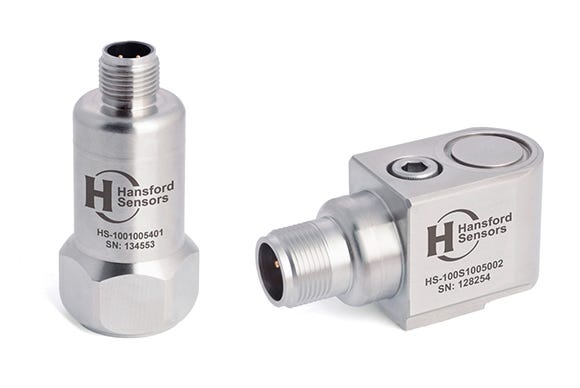Choosing The Right Sensor for Vibration Analysis
In this story, I’m going to tell you what I did in last ten days to choose the right vibration sensor for my project. if you want to measure vibration and you’re lost in thousands of datasheets, this is a story for you.
The Goal
Measuring the vibration of rotating machinery.
Which Kind of Sensors can be used?
as I mentioned in the previous story, to measure vibration we may measure displacement, velocity or acceleration. so we can use displacement sensors, velocity sensors or accelerometers.
Vibration is most commonly measured using an accelerometer. An accelerometer is a sensor that measures the dynamic acceleration of a physical device as a voltage.

Applications of Accelerometers
Accelerometers are capable of measuring acceleration, tilt, and vibration or shock, and, as a result, are used in a diverse range of applications like:
- Test and measurement
- Health usage monitoring system (HUMSs)
- Acoustic emissions
- Crash or Impact Detection
- Vibration Control and Monitoring
- Shock Detection
- Vehicle collision sensing
- Crash sensing
- Handsets
- Medical instrumentation
- Gaming and pointing devices
- Industrial instrumentation
- Personal navigation devices
- Hard disk drive (HDD) protection
- Condition monitoring
- Predictive maintenance
- Asset health
- …
As mentioned above, condition monitoring and predictive maintenance which are referring to vibration analysis is one of accelerometer’s application so we continue with this application in detail. talking about other applications is not in this satori's scope.
Types of Accelerometers for Condition Monitoring
There are many types of accelerometer and on the top, there are piezoelectric and MEMS.
Piezoelectric
Most accelerometers rely on the use of the piezoelectric effect, which occurs when a voltage is generated across certain types of crystals as they are stressed. The acceleration of the test structure is transmitted to a seismic mass inside the accelerometer that generates a proportional force on the piezoelectric crystal. This external stress on the crystal then generates a high-impedance, electrical charge proportional to the applied force and, thus, proportional to the acceleration.

MEMS
Microelectromechanical systems (MEMS, also written as micro-electro-mechanical, MicroElectroMechanical or microelectronic and microelectromechanical systems and the related micromechatronics) is the technology of microscopic devices, particularly those with moving parts.

The Big Decision, Let’s go state of art!
Piezoelectric (or so-called mechanical sensors) are widely used in industry for vibration analysis for years and they play the major role at the moment. this is because MEMS are not suitable to measure high frequency and they also have high noise.
The key criteria for CBM accelerometers are low noise and wide bandwidth. At the time of writing this article, very few competitors offer MEMS accelerometers with bandwidths above 3.3 kHz, with some specialist manufacturers offering bandwidths up to 7 kHz.
With the advancement of Industrial IoT, there is an emphasis on reducing cabling and utilizing wireless, ultra-low power technologies. This places MEMS accelerometers ahead of piezoelectric accelerometers in terms of size, weight, power consumption, and potential for integrated intelligent features.
In recent months, some manufacturers (will discuss later in the story) introduced low noise and high-frequency MEMS specially designed for condition monitoring and they put themselves ahead of piezo ones with their tempting features.
so I decided to go with MEMS because of:
- Low cost (a very good MEMS is around 50$ this is when a normal industrial piezoelectric is about 1000$)
- Higher Accuracy
- Ultra-low noise
- High Frequency (not as high as piezo, but more than enough for what we need)
- Compatible with IoT platforms
- Low Power (can work on battery, which is perfect for my project since I want to install in on the machine forever. this is when piezo is usually used for periodic sampling like once a week)
- It’s state of art (close to smart factory concept)
- …
Important Features
accelerometers have a bunch of features that make the decision hard for us. among a lot of features some are much important, especially in condition monitoring.
Sensitivity
Sensitivity is one of the most important parameters for accelerometers. It describes the conversion between vibration and voltage at a reference frequency, such as 160 Hz. Sensitivity is specified in mV per G. So the sensitivity of an accelerometer means how accurate is the output. for major condition monitoring application, 100 mV/G is more than enough. for other applications like tilt detection 1 mV/G is fair enough.
Range / Vibration Amplitude
The maximum amplitude or range of the vibration you are measuring determines the sensor range that you can use. If you attempt to measure vibration outside a sensor’s range, it distorts or clips the response. Range means the range of Gs which the accelerometer is capable to measure and it’s expressed like +-2g. for condition monitoring of rotating machinery, +-2g is fair enough because the vibrations are rarely more than 1g. but for other applications like shock detection, it can be up to +-1000g.

Bandwidth
Bandwidth or frequency means the range of frequencies which the sensor can capture. for example, if you have motor which is working at 1500 rpm (25 Hz) and you want to detect unbalance fault, which occur on 1x (x means the speed a rotating machinery, here is 1500 rpm or 1500 rpm or 25 rps or 25 Hz) so you need a sensor with minimum 25 Hz bandwidth to capture the motion of unbalance part. for more complicated faults like misalignment we need more bandwidth because it occurs for example on 4x and 5x so we need at least 125 Hz. more info:
it is recommended to have a sensor with at least 20X frequency bandwidth then it can cover almost all of defects on that machine.
Number of Axis
Vibration of machine can occur on different directions, so it’s important to mount the sensor on a proper point on the machine to be able to capture the vibration. for example, if we are going to detect a simple unbalance defect, like this:

it has a vibration on Y axis in each round. so we have to mount the sensor on Y axis to capture this motion.

In the market, there are sensors which can capture only one axis, and there are also sensors which can capture two and three axis a the same time.

In fact, we can use a simple single axial sensor to detect all the faults, how? simply mount it on different points! once in X axis, once in Y axis and Z axis if needed. and this is what usually happens in industry because most of industrial sensors are single axis and it’s also pretty simple to mount and demount the sensor quickly.
BUT in our case, which I want to mount the sensor on the machine for ever, we probably need a triaxial sensor to capture all motions.
Noise
Electrical noise in appears in output of the sensor that affects the results. as you know, we are capturing ultra low motions in machines, so we need an ultra noise sensor. if there are high noises, we can’t see anything in time waveform or spectrum.
Piezoelectrics usually have low noise like 200 µg/√Hz. The first generation of MEMS had high noises like 4 mg√Hz, unacceptably high for most condition monitoring applications. For the second generation device used in the comparison, noise is reduced two orders of magnitude from the first generation and it’s about 100 µg/√Hz. even lower than piezoelectrics!
Sampling Frequency
Sampling frequency means how many records the sensor captures in one second and it’s expressed in Hz. you may confuse it with bandwidth frequency, well, bandwidth frequency means how many records it CAN measure and sampling frequency means how many records it REALLY give us in the input.

in the above picture, we measured the black line diagram with the sensor (bandwidth) and the output are the blue points. we have to choose the right sampling frequency, if we choose lower than what we need, we may see a wrong diagram like this:

it’s recommended to have a sampling frequency more than two times of the largest harmonic (in FFT). for example in an unbalance fault, the largest harmonic appears on 1x so in a 1500 (25 Hz) rpm motor, we may need sampling frequency to be at least 50 Hz.

Mounting Options
Another consideration for your vibration measurement system is how to mount the accelerometer to the target surface. You can choose from four typical mounting methods:
- Handheld or probe tips
- Magnetic
- Adhesive
- Stud mount

Stud mounting is by far the best mounting technique, but it requires you to drill into the target material and is generally reserved for permanent sensor installation. The other methods are meant for temporary attachment. The various attachment methods all affect the measurable frequency of the accelerometer. Generally speaking, the looser the connection, the lower the measurable frequency limit. The addition of any mass to the accelerometer, such as an adhesive or magnetic mounting base, lowers the resonant frequency, which may affect the accuracy and limits of the accelerometer’s usable frequency range. Consult accelerometer specifications to determine how different mounting methods affect the frequency measurement limits. Below Table shows typical frequency limits for a 100 mV/G accelerometer.

Let’s Go to the Market
So far I know what’s the right sensor for my application. However I don’t have the exact specification of what I’m going to do next but I guess I will have a motor which is not going to work more than 1500 rpm and I’m going to detect unbalance and a simple bearing fault or maybe misalignment. and I also decided to use MEMS because of the mentioned reasons, on the top, there is compatibility with IoT, low cost, and low power.
It’s time to go the market to purchase the right sensor! When you start searching for accelerometer sensor, the major results are about simple accelerometers used in mobiles for tilt or motion detection since there are a lot of Android and iOS developers out there, trying to create new apps! so you may go for “Industrial Accelerometer” or “Accelerometer for Vibration Analysis” or “Vibration Analysis Sensor” then will drop in a lot of manufactures which create piezoelectric sensors. most prominent manufactures are Bentley Nevada and CTC.
So, where are the MEMS? as I said, MEMS are coming to age of condition monitoring recently. so you can’t find much MEMS accelerometer for monitoring. Top manufacture for MEMS specially designed for condition monitoring is Analog Devices.
The ADXL354/ADXL355 and ADXL356/ADXL357 are well suited to condition monitoring applications based on their ultra-low noise and stability over temperature, but ultimately their bandwidth precludes them from performing more in-depth diagnostic analysis. The new ADXL100x family of single-axis accelerometers are optimized for industrial condition monitoring and offer wide measurement bandwidths up to 50 kHz, g-ranges up to ±100 g, and ultra-low noise performance — putting them on a par with piezoelectric accelerometers in terms of performance.
Further complimenting this range of MEMS accelerometers is the first generation of subsystems for CBM, ADIS16227 and ADIS16228 semiautonomous, fully integrated, wide bandwidth vibration analysis systems, with features such as programmable alarms over six spectral bands, 2-level settings for warning and fault definition, adjustable response delay to reduce false alarms, and internal self-test with status flags. Frequency domain processing includes a 512-point, real-valued FFT for each axis, along with FFT averaging, which reduces the noise floor variation for finer resolution. The ADIS16227 and ADIS16228 fully integrated vibration analysis system can reduce design times, reduce costs, minimize processor requirements, and reduce space constraints, making them ideal candidates for CBM applications
